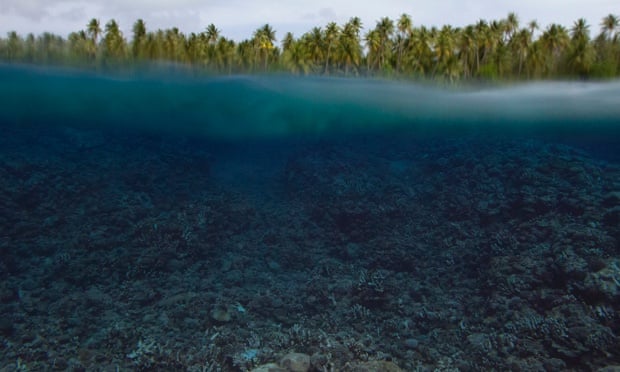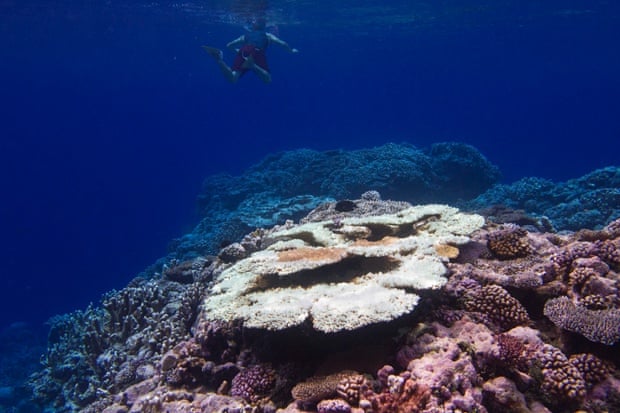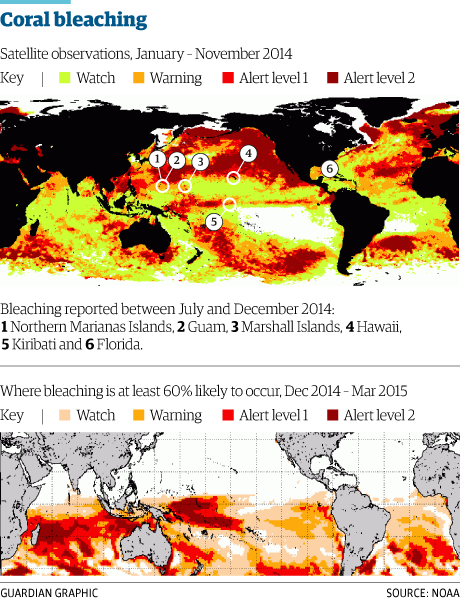Warm sea temperatures are causing massive coral reef die-off across the Northern Pacific in what could be the start of an historic bleaching event around the world

The destruction of coral reefs will make these vital barriers for the land less effective against the effects of climate change - such as sea level rise and storms. Location: Arno atoll, Marshall Island. Photograph: Remi Chauvin
Scientists warn extreme sea temperatures could cause a “historic” coral reef die-off around the world over the coming months, following a massive coral bleaching already underway in the North Pacific. Experts said the coral die-off could be the worst in nearly two decades.
Reports of severe bleaching have been accumulating in the inbox of the US National Oceanic and Atmospheric Administration’s (NOAA) Coral Reef Watch programme since July.
A huge swathe of the Pacific has already been affected, including the Northern Marianas Islands, Guam, the Republic of the Marshall Islands, Hawaii, Kiribati and Florida. Some areas have recorded serious bleaching for the first time.
“On a global scale it’s a major bleaching event. What it may be is the beginning of a historic event,” said Coral Reef Watch coordinator Dr Mark Eakin.
In the Marshall Islands, bleaching of unprecedented severity is suspected to have hit most of the country’s 34 atolls and islands. The Guardian witnessed devastated expanses of coral that look like forests covered with snow.
Warm water will soon begin hitting reefs in the southern Pacific and the Indian Ocean as the seasons and currents shift. Eakin said coral watch modelling predicts bleaching on Australia’s Great Barrier Reef as early as January.

Table corals provide an excellent hiding place for smaller fish. In some areas of the Marshall Islands, up to 100% have been killed by the spike in sea surface temperatures since September. Location: Arno atoll, Marshall. Photograph: Remi Chauvin
Bleaching is caused by persistent increases in sea surface temperature. Just 1C of warming lasting a week or more can be enough to cause long-term breakdown of reef ecosystems.
The worst coral bleaching event on record is a mass die-off during 1998. A massive El Niño event combined with climate change to raise global sea and air temperatures to never-before-recorded levels and killed around 15% of the world’s corals.
2014 has already surpassed 1998 as the hottest year recorded - with a mild El Niño still predicted in the new year.
Professor Ove Hoegh-Guldberg, a coral reef expert from the University of Queensland, said the current bleaching event was on track to be as bad or worse than 1998.
“Many coral reef scientists are expecting something similar to 1997-98 to unfold in the next six to 12 months.”
Eakin said even under a weak El Niño, bleaching could continue until 2016 – lasting twice as long as the 1998 event. High sea surface temperatures due to climate change are making El Niño a less decisive factor in coral bleaching.
“Despite the fact that there’s really not a big El Niño, we’re seeing these patterns of severe bleaching. So what’s happening is, as global temperatures increase and especially as the ocean warms through the increase of carbon dioxide and other heat trapping gases in the atmosphere, it’s warming the ocean so that it doesn’t take as big an El Niño to have the same effect on water temperatures,” said Eakin.

In some areas in the Marshall Islands, almost all the coral has been bleached. Photograph: Remi Chauvin
Initial analysis of the Guardian’s photos from the Marshallese atoll of Arno showed its reefs could be added to the fast-growing list of seriously affected places. In less extreme temperatures bleached coral may not die completely.
But Karl Fellenius, a coral reef manager from the University of Hawaii said that in the Marshall Islands “it’s looking like the thermal stress was so profound that the corals died within days of getting bleached”.
This does not augur well for the future of the world’s reefs under climate change.
“The real problem is that recovery from a major bleaching event can take decades and these events keep coming back every 10 years or less… [Reefs] just don’t have time to recover,” said Eakin.
The combined effect of rising temperatures and sea levels – corals can only survive near the surface – could mean the end for coral reefs in the next 50 years even if world leaders combine to keep global temperature rise below their target of 2C, said Hoegh-Guldberg, who was lead oceans author for the UN’s definitive climate science report.
“Temperatures projected under even mild climate change scenarios may be too damaging to coral reefs for them to survive beyond the mid to late part of this century.”

http://www.theguardian.com/environment/2014/dec/19/major-coral-bleaching-pacific-may-worst-20-years#comments
